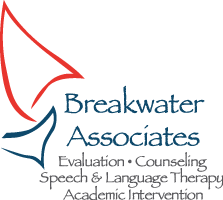Dyslexia Therapy
Dyslexia Therapy at Breakwater Associates
Scientific research reveals that dyslexia is a language-based learning disability. As recommended by experts in the field of reading and language research, Breakwater Associates employs the Orton-Gillingham based approach (also referred to as a structured literacy approach) for the remediation of dyslexia and reading problems due to other factors. An Orton-Gillingham approach (Structured Literacy Approach) offers direct instruction in the structure of the English language that is simultaneously multi-sensory, systematic, sequential, explicit, and prescriptive.
An Orton-Gillingham approach (Structured Literacy Approach) provides instruction in:
Phonemic awareness – the knowledge and ability to recognize that words are made up of a combination of individual speech sounds
Phonics – knowledge of the alphabetic Code, which is the knowledge of the 26 letters of the English language, the 44 sounds of the English language and approximately 70 common spellings of these speech sounds
Orthography- the conventional spelling system of the English language
Handwriting – handwriting is directly taught and also interwoven into reading, spelling, and writing instruction
Morphology – the study of the forms of words, and the ways in which words are related to other words of the same language
Vocabulary Development – words that a student is able to understand and use in both oral and written language
Fluency – the ability to read text rapidly, accurately, and smoothly
Comprehension – the goal of reading instruction that should follow the ability to read fluently
Our reading instructors are Orton-Gillingham trained and/or certified and skilled at flexible and individualized teaching. Instruction is prescriptive, in that it is based on careful and continuous assessment of the students’s needs. As the student progresses through individually prescribed lessons and activities, the tutor and student use a variety of progress monitoring tools, including phonogram and word lists, to assess progress and make appropriate adjustments. Students are expected to achieve mastery for each concept before progressing to the next.
Reading instructors at Breakwater Associates use a variety of manipulatives, often intertwining programs and activities, to meet the individual needs of all of their students.
Breakwater Associates is a member of The International Dyslexia Association
